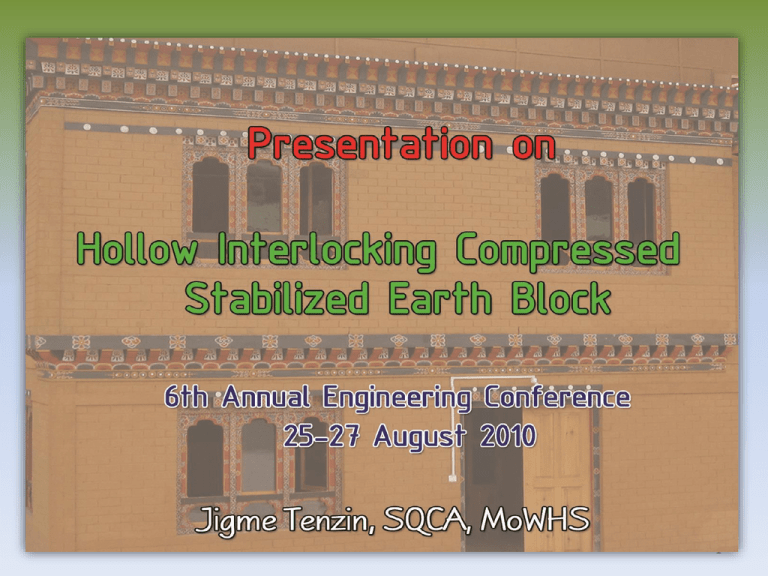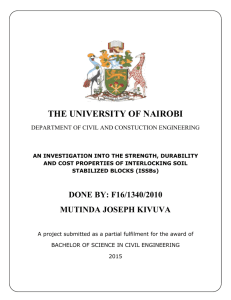Hollow Interlocking –Compressed Stabilized Earth Block
advertisement

1 Construction Industry and its Impact to Built Environment 2 Construction Industry account for one-sixth of the world's fresh water withdrawals, onequarter of its wood harvest. The cement sector alone accounts for 5 % of global man made CO2 emissions 3 Construction & Demolition (C&D) generate between 10% and 40% of the solid waste stream in most countries (Kibert et al, 2000). C&D wastes can generally be used for low-priority works like footpaths, drains, pavements etc. Most bonding & drying agents in carpets, veneers, particle board, plywood and paint emit volatile organic compounds (VOC’s) which contribute to greenhouse gases and global warming. Pollution and Waste 4 Environmental impacts Resource depletion Physical disruption Chemical pollution Other effects; Social disruption, undesirable visual impact. Social impacts Economic impacts Loss of open space & biodiversity Social Isolation Increased car dependency Decreased air quality Unhealthy indoor environment To Builders: Increased compliance costs & waste disposal costs To Owners: Increased utility & maintenance costs To Occupiers: Loss of well being & productivity To Society: Decreased environmental quality • According to the World Watch Institute about 40% of the world's total energy usage is dedicated to the construction and operation of buildings. • The building industry consumes 3 billion tons of raw materials annually, 40% of the total material flow in the global economy. • Only about 0.003 % of earth's water is readily available as fresh water for human use (Miller, 1992). Building materials manufacturing, construction and operations consumes 16% of available fresh water annually • In 1990 the building industry consumed 31% of Global energy and emitted 1900 Megaton's of Carbon. Towards an innovative & eco-friendly Construction Industry 7 GREEN Building ‘Continued ability of a society, an ecosystem, or any such interactive system to function without exhausting key resources and without adversely affecting the Environment’ Principles: 1. Maximizing the use of renewable and natural resources; 2. Minimizing the use of energy and water; 8 Green Buildings Materials Green building materials offer specific benefits to the building owner and building occupants: Reduced maintenance/replacement costs over the life of the building; Energy conservation and reduce harmful emissions; Improved occupant health and productivity; Lower costs associated with changing space configurations; Do not exhaust the existing supplies of finite materials; 9 Choosing Building Materials Underlining Principle: Assuming that all stages in the life of a material right from extraction, manufacture, transportation to the installation, operation, maintenance and the recycling and waste management cause some degree of Environmental impact which needs to be evaluated.- This is called Life Cycle Analysis (LCA) for any material/product. 10 Characteristics of Sustainable Managed Alternatives 1. CEMENT CONCRETE Energy Intensive industry Depletion of natural resources Green house gas emissions 11 Recommended Alternatives: 1. Blast furnace Slag Concrete Using Ground Granulated Blast Furnace slag with Cement (from steel plants) in mixes 12 Recommended Alternatives: 2. Using Recycled Aggregates Crushed Concrete, Bricks and other masonry waste 13 3. Mortars and Plasters: Basic Mortar used: 1 : 6 (Cement : Sand) 1. Cement : Lime : Sand (1 : 1 : 6) 14 2. Lime : rha : Sand (1 : 1 : 1) rha: Rice husk ash - hard protecting coverings of grains of rice (burnt) 15 Looking back to think ahead…………….. Our predecessors knew it better……. We were much less resource dependent in the past 16 RAMMED EARTH AND MUD BLOCKS CONSTRUCTION IN BHUTAN 17 Earthen Construction Technology A brief History Tabo Monastery , HP – India , 996 AD Our Very Own Auroville-Earth Institute Shey Monastery, Ladakh 17th Century Aman, Gangtey Ramasseum, Egypt Around 1300BC Innovative Building Technologies: Hollow Interlocking-Compressed Stabilized Earth Block (HI-CSEB) 19 Innovative Building Technologies: Machine that produces HI-CSEB, developed by Auroville Earth Institute, Tamil Nadu, India Aurum Press 3000 20 HI-CSEB Economical/affordable, environmentally friendly, easily available, stronger, energy saving and simple to manufacture Better Thermal Insulation Warm in winter and cool in summer 21 Technical /Engineering Aspects Block Production Material selection Soil Identification – Top soil and soil with organic matter should not be used. Grain size distribution - more of sandy is preferred. Gravel (mm) Sand(mm) Silt(mm) Clay(mm) 20 to 2mm 2 – 0.02 0.02 – 0.002 0.002 - 0 Some basic test for identifying the suitability of soil Granularity (Grain size distribution test) -Compressibility (Ease of the soil to be compressed) Humus (presence of organic materials0 Plasticity ( Capacity to withstand deformation) Cohesion(Property of the soil grains to remain together) • 15%gravel, 50%sand, 15% silt, 20%clay • Compress a moist soil by hand • Difficult to compress – gravely soil • Very easy to compress – Clayey soil • Smells Rotten – lot of humus • Musty – humus • Agreeable smell – no humus - suitable for construction • Difficult to break – clayey soil • Breaks easily – gravely soil • Wash the hand on which the soil paste was made • Soils grains does not stick on the palm – Gravely soil • Thin film of soil stick on the palm – clayey soil. Proportions • Cement : Soil (1 : 6) • Water content = 25 liters for one bag of cement • Varying the ratio esp. the cement has the proportionate cost involved • The ratio can go up to 1 cement to 10 soil 24 Same basic data on CSEB Properties Dry Compressive Strength @28days Wet compressive strength @28days (3days immersion) Dry bending Strength @28days Dry Shear Strength @28days Values 3 – 6Mpa (N/sqmm) ( +10% after 1 year, 20% after 2years) 2 – 3 Mpa 0.5 – 1 Mps 0.4 – 0.6Mpa Density 1700 to 2000kg/cum Water absorption @ 28days after 3 days immersion 8 to 12 % by weight Energy Consumption 110MJ ( Kiln fired bricks = 539MJ) Comparison with other building blocks Properties CSEB (HI - 245) Ordinary class III brick Concrete hollow blocks Size 245x 245 x 95 195 x 95 x 75 390 x 190 x 190 Weight 8kg 3kg 16kg Compressive strength (28days) 30 – 60kg/cmsq 35kg/cmsq 45kg/cmsq(approx) Cost (Nu.) 13 per block ( 1:6 mix ratio) 11 per brick @ Thimphu 38.00 per block @ Thimphu For a 250mm thick 1msq wall in a load bearing building @ Thimphu Block Numbers Cost(Nu) HI - CSEB 40(Approx) 520 Ordinary second class brick 166(approx) 1496.00 Hollow concrete Block 19.5(approx) 741 Block production machines Two Machines in the market 1) HI – CSEB Block machine – Habitech centre, Thailand Designer/ manufacturer Cost of Press Habitat centre , Bangkok 73,500.00 (Nu) 2008 rate Cost of Mould ( 1 set) - Max Blocks size 300 x 150 x 95 Production capacity per day ( 6- 7 workers) 500 average 2) AURUM PRESS 3000 – Auroville,India Designer/ manufacturer Auroville Earth institute/ Aureka, Cost of Press Rs 69,800.00 Cost of Mould ( 1 set) Rs 41,500.00 Max Blocks size 245 x 245 x 95 Compression force 150KN( 15 tones) Production capacity per day with 7 workers 500 Blocks (average) Pilot House Construction – SQCA using HI – CSEB 245 • Two storied load bearing structures - serve as model for the earthquake resistant design features • Sample Blocks test results Soil sample source Average Compressive Strength Proposed construction site (1:8 mix ratio 22 kg/cmsq Buddha Dodema site ( 1: 8) 33 kg/cmsq SQCA – Pilot Project 29 Hollow Interlocking –Compressed Stabilized Earth Block (HI-CSEB) 30 Pilot house using HI-CSEB 31 Some other buildings using HI-CSEB 32 Advantages 1. 2. 3. 4. Use of cheap & locally available materials Job opportunity for local people Biodegradable materials Energy efficiency and eco friendliness 5 – 15 times less energy consumed than fired brick and around 3 – 8 times less emission 5. Transferable technology 6. Import Reduction Advantages 7. Cost effectiveness 8. Minimum mortar required 9. Keys that interlock with each other provides better integrity 10. Hollow provisions for laying vertical and horizontal reinforcements to improve the lateral load resisting capacity 11. Ease and Fastness in construction 12. Fire resistant Limitations • Only for low rise structures: maximum 2 storey • Strength very much dependant on the properties of soil • Too much stabilization(cement) will make no economic sense • Interlocking features do not provide air tightness. Minimum gap is formed due to which termite/air current can pass. Limitations • Requires minimum mortar between the blocks to maintain horizontal construction level • Too much mortar between the blocks jeopardizes the interlocking feature • For frame structures, HI-CSEB can be used as filler materials but the structural members sizes increases due to increase in the block weight HI-CSEB in Bhutan • No of private individuals who procured the machine-2 • Commercial basis- Established in Jemina by 2 firms Way forward 1. Conference on GREEN Construction – Awareness and exchange of knowledge; 2. Sensitization w/shops & trainings in Green building practices; 3. Standards and regulations; R & D required Formulation of standards and guidelines Conclusion • Sustainable /economical/eco friendly building material • Easy and simple technology • Creates employment opportunities • Reduce dependency on import of bricks • Making housing affordable Therefore, production and construction with HCSEB is relevant and it is to be adopted where ever possible. Thank you and Tashi Delek www. sqca.gov.bt









